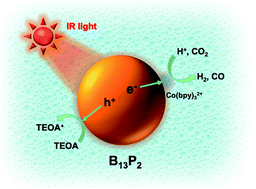Tridecaboron diphosphide: a new infrared light active photocatalyst for efficient CO2 photoreduction under mild reaction conditions†
Abstract
The search for efficient infrared (IR) light responsive photocatalysts for photocatalytic CO2 reduction is highly desirable but remains a huge challenge. Herein, tridecaboron diphosphide (B13P2) is demonstrated as an effective IR light active photocatalyst for the photocatalytic CO2 reduction reaction. Specifically, B13P2 enables efficient IR light driven photocatalytic CO2 reduction with a CO evolution rate of 0.13 μmol h−1 and an apparent quantum efficiency (AQE) of 0.07% under monochromatic light of 810 nm in the presence of Co(bpy)32+ (bpy = 2′2-bipyridine) as a cocatalyst, representing a state-of-the-art IR light active photocatalyst. Both the theoretical and experimental investigations indicate that B13P2 is a zero bandgap material showing strong light absorption ranging from the ultraviolet to the IR region, and electron–hole pairs can be generated by the interband transitions between energy orbitals after absorbing photons to participate in photocatalytic reactions.



 Please wait while we load your content...
Please wait while we load your content...